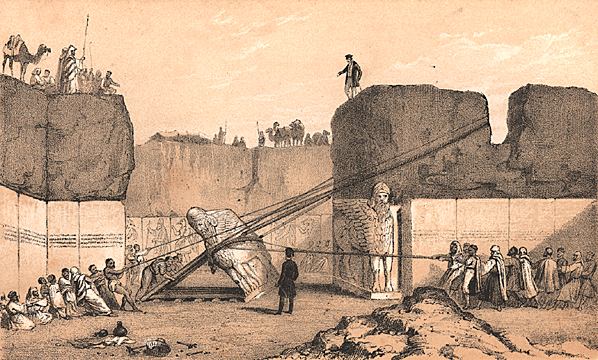After 2,700 years, the walls and gates of ancient Nineveh can still be seen near the banks of the Tigris river just opposite the modern city of Mosul in Iraq. In ancient times, it was the capital of the great Assyrian empire, a city of more than 100,000 people, and it was a subject of a supreme being's attention throughout the books of the Old and New Testaments in the biblical account. "Now the word of the Lord came unto Jonah the son of Ammittai, saying, Arise, go to Nineveh, that great city, and cry against it; for their wickedness is come up before me."[1] The prophet Jonah's efforts there were rewarded. Nineveh, at least for a time, was saved from destruction. But the city of Nineveh today will require a different kind of saving. There are comparatively few people living there now. It features mostly ruins. Even the ruins, however, will disappear unless, according to the Global Heritage Network's early warning system, urgent steps are taken to arrest the elements that endanger it and to restore and protect what is left.
Not an easy thing to do these days in a war-torn country. War has distracted and preoccupied the energies of a people who otherwise could be identifying and procuring the necessary resources needed to save and protect the city.
But long before war, it has been plagued by looting and vandalism. Artifacts have appeared on international markets for sale, reliefs have been marred by vandalism, and chamber floors have seen holes dug into them by looters hoping to find anything that will yield cash for their needs. The expanding suburbs of adjacent Mosul, too, threaten it with encroachment, with sewer and water lines having already been dug and new settlements already established within the area once occupied by the ancient city.
Even without looting, vandalism and suburban encroachment, however, Nineveh will crumble and succumb to the natural elements. Reports the Global Heritage Fund (GHF)*, a non-profit organization that specializes in saving and restoring archaeological sites, "without proper roofing for protection, Nineveh's ancient walls and reliefs are becoming more and more damaged by natural elements every day. Exploration of the city is an important objective at this time, but preservation measures would go a long way as well".[2]
Historically, the site of ancient Nineveh, which consists of two large mounds, Kouyunjik and Nabi Yunus ("Prophet Jonah"), has been the subject of numerous excavations and exploratory expeditions since the mid-19th century. Beginning with French Consul General at Mosul, Paul-Émile Botta in 1842, and most notably through the excavations of famous British archaeologist Austen Henry Layard (pictured right) and many others thereafter, the remains of Nineveh became one of the sensational archaeological revelations of modern times. Before that, Nineveh, unlike the clearly visible remains of other well-known sites such as Palmyra, Persepolis, and Thebes, was invisible, hidden beneath unexplored mounds. Even historical knowledge of the Assyrian Empire and its capital city was sparse in the beginning, changed primarily by the great archaeological discoveries that followed Botta's initial attempts. One palace after another was discovered, including the lost palace of Sennacherib with its 71 rooms and enormous bas-reliefs, the palace and library of Ashurbanipal, which included 22,000 cuneiform tablets. Fragments of prisms were discovered, recording the annals of Sennacherib, Esarhaddon, and Ashurbanipal, including one almost complete prism of Esarhaddon. Massive gates and mudbrick ramparts and walls were unearthed. The walls encompassed an area within a 12-kilometer circumference. Many unburied skeletons were found, evidencing violent deaths and attesting to the final battle and siege of Nineveh that destroyed the city and soon brought an end to the Assyrian Empire.
Despite its long history of excavation, the ancient site of Nineveh leaves much to be explored. But conservationists and others are arguing that further excavation and exploration would be pointless without a concerted, meaningful plan and efforts to preserve the finds for posterity, beginning first with what has already been uncovered. "Nineveh has already been heavily attacked by looters, and now development pressures from nearby Mosul have begun to take their toll as well," reiterates GHF. "If this encroachment continues, Nineveh's ancient remains could again be buried forever."[2]
In an October 2010 report titled Saving Our Vanishing Heritage, Global Heritage Fund designated Nineveh among the top 12 sites in the world most "on the verge" of irreparable loss as a result of looting, development encroachment, and insufficient management of its cultural resources.
For more interesting topics related to archaeology, visit archaeology excavations.
Archaeology excavation is best known and most commonly used within the science of archaeology. In this sense it is the exposure, processing and recording of archaeological remains.
Wednesday, August 24, 2011
Saving Ancient Nineveh
Subscribe to:
Post Comments (Atom)

No comments:
Post a Comment